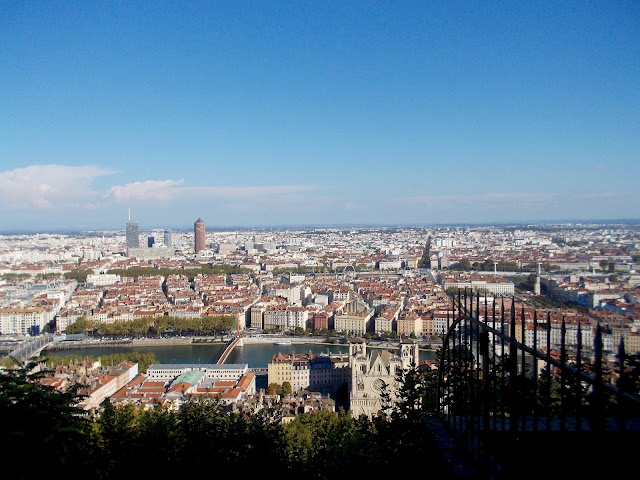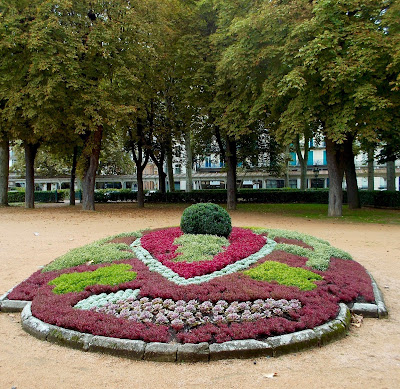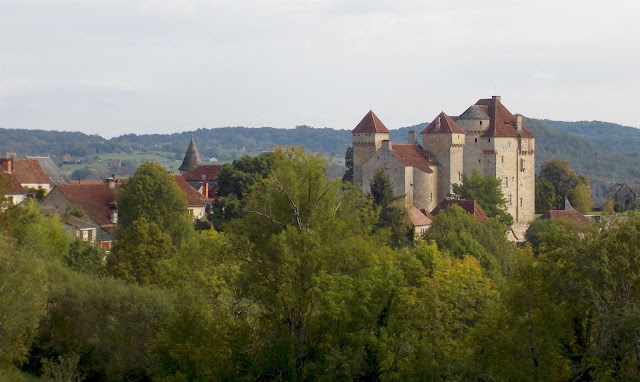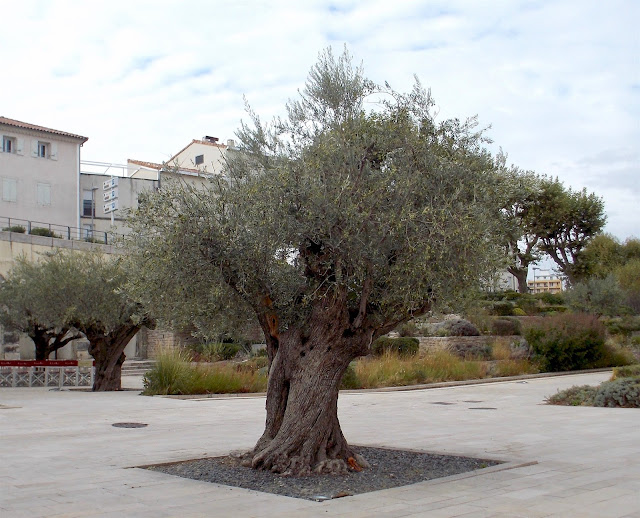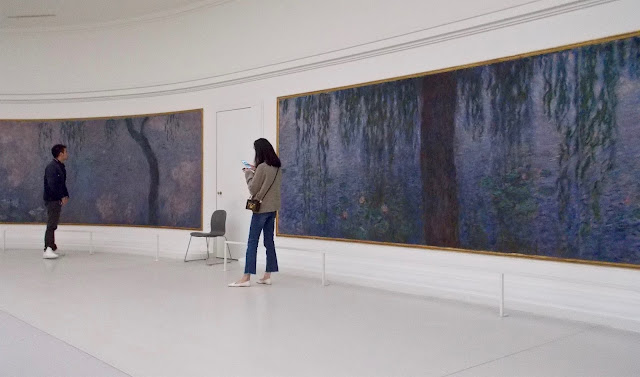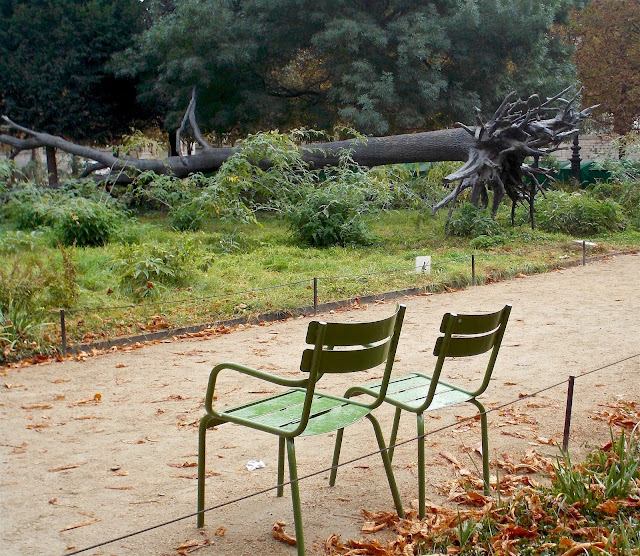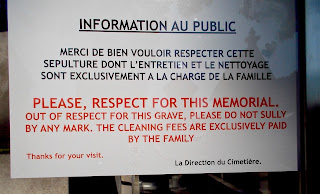September 26 -29
We arrived in Lyon after the long flight from Vancouver followed by an easy, swift, 2-hour ride on the TGV (bullet train) from Charles de Gaulle airport near Paris to Lyon's Gare-Dieu railway station. By the time we reached Vieux Lyon on a local bus it was 2 pm local time and we'd been up for 20 hours. So it was great to find Bénédicte, our Airbnb hostess, waiting for us at the bus stop to guide us to our tiny studio apartment on the 4th floor of an old building. Access was through a door in the street wall, along a gloomy passage and up in a minuscule elevator.
The studio itself was bright and welcoming, perfect for a short stay. Its windows looked down onto one of the typical cobbled streets of the neighbourhood.
Only residents' cars use these narrow streets so there was very little traffic noise.
Most restaurants have most of their tables on the sidewalk to accommodate smokers. Inside, where it's required to be smoke-free, there's little space but fewer people. We found throughout our travels in France that the majority of customers still smoke and it seemed particularly common among the younger crowd. When the weather got colder and more people opted to sit inside, they would often get up and leave their table, their bags, sunglasses, etc and disappear for 10 to 15 minutes to have a cigarette outside.
The following day, struggling with jet lag, we had a slow start. Michael went out to get croissants and coffee which we ate at our little kitchen counter, before heading out to explore. First stop was the information centre where we decided to buy tickets for the hop on/hop off bus tour, figuring it wouldn't be too demanding and would give us an overview of the city. Among the first sights we passed were a couple of Lyon's famous trompe-l'oeil murals.
I was impressed by some of the street plantings in appropriate autumnal colours.
Two great rivers run through Lyon, the Rhone and the Saone
Flowing each side of Presqu'ile, the "almost island", they meet at La Confluence on the southern edge of the city. Originally an industrial area, home to tanneries and foundries, La Confluence has been recently converted into a residential and tech community. We got off the bus there to take a closer look at its very modern, look-at-me architecture.


From the angle I photographed it their Museum of Man looks like a turtle that has just surfaced and realized it has lost its way. It was designed by Austrian firm Coop Himmelb(l)au - and yes, those brackets are part of the title!

Real innovation was apparent in the former warehouse conversions, which had adapted former loading platforms to create balconies for the apartments within.
Along the road between these buildings and the river runs Lyon's experimental driverless bus.
It crawls along, stopping if a pedestrian crosses its path. If people are walking along the road in front of it, which they often do for long stretches of this largely pedestrian thoroughfare, it trails behind them like a reluctant puppy. In case of unexpected hazards, it has an operator who can override the controls but his main activity appears to be keeping a record of the riders. We were the only ones on this particular pass along the waterfront.
After a quick lunch we boarded another tourist bus to take us up the hill to Fourvières, where a grand white cathedral overlooks the city.
Inside, we found a soaring space with a beautiful gilded ceiling.
The walls were lined with mosaics, also gilded, showing biblical scenes ...
... and Joan of Arc.
From the terrace around the cathedral we had a panoramic view of the city.
The following day when we climbed the Croix-Rousse hill across the Saone River from Fourvières, we could see why irreverent locals refer to the cathedral and its adjoining mini-Eiffel tower as the upside-down white elephant.
Descending from Fourvières on foot took us through groomed parks and down steep staircases.
At the bottom we stopped at a "glacier" for fruit sorbets before wandering back towards our temporary home through streets selling postcards (do people still send them?) and tourist souvenirs.
In the evening we searched through the pedestrian streets of Presqu'ile for a restaurant that might cater to my chicken/fish/veggie tastes. Many of the small restaurants called "bouchons" looked appealing, but their menus included a lot of red meat.
Fortunately, we found La Traboulerie, a very convivial little place with fish on the menu: quenelles de brochet avec sauce Nantua, i.e. pike dumplings with lobster sauce. The fish was good and so were the salads we ordered.
For our last day in Lyon, we planned to hit the museums, starting with the Musée des Beaux-Arts, whose collection is promoted as second only to the Louvre in Paris. Entry was through a pretty courtyard.
Their sign in the foyer, advising what visitors could and could not do, was very effective.
The works on display were mainly large Academy paintings of biblical scenes,

... plus some modern pieces
I thought a Great Dane was an inspired choice for this piece of marble.
We bought take-out baguettes with a choice of fillings for lunch. The friendly baker even threw in a couple of free pastries. Central Lyon has few parks and plazas, so we crossed back over the Saone and found a bench on a sandy promenade under some trees.
In the afternoon we went to the Musée de l'Imprimerie, a museum dedicated to the history of print. This proved to be very entertaining, with lots of interesting posters, both historic and recent, old presses, cases of lead type, and some fascinating examples of old cast lead plaques - like this one for a throat institute with an illustration from a La Fontaine fable:
"A feeding wolf got a small bone stuck in his throat and, in terrible
pain, begged the other animals for help, promising a reward. At last the crane agreed to try and, putting his long bill down the wolf’s throat,
loosened the bone and took it out. But when the crane asked for his
reward, the wolf replied, "You have put your head inside a wolf’s mouth
and taken it out again in safety; that ought to be reward enough for
you."
I also liked this one:
On our final morning in Lyon, we climbed the Croix-Rousse hill through dry, dusty vegetation to take in the view of Fourvières across the river (see above). As we descended through the narrow alleys ...
... we came to a dramatic retaining wall, on which were painted renditions of photos we'd seen in our copy of Earth From Above by French photographer Yann Arthus-Bertrand. In between the paintings were metal grids hung with flourishing greenery, a great contrast with the burnt red background of the wall.
After tidying the studio and returning the keys to Bénédicte, we set off for Part-Dieu station where we picked up our rental car and headed northwest for Pérouges, a picturesque old hill town.
FROM LYON TO VICHY
September 29 -30
The sky was cloudless and blue, the temperature somewhere in the '30s. Pérouges, when we reached it, provided car parking on the outskirts. We walked through quiet, cobbled streets dappled with sun and shade into the main square, where a few tourists were seeking shade and cool drinks under a massive tree whose outstretched limbs were supported by sturdy wooden poles.
Elsewhere, the town seemed asleep. No shops were open, although through an open window we saw bread rising in a bakery's kitchen...
... and corncobs hung to dry under a shady colonnade.
We continued along winding roads through fields of corn, grapevines and dying sunflowers to Villefranche-sur-Saone, a large town and the focus of the Beaujolais wine-growing region. At the information centre we obtained a map of the 'Route du Vins Beaujolais' and a brochure of lodging places. Following the map took us through more pretty countryside.
Unfortunately, it seemed most of the attractive little villages in the region were taking a break between their summer visitors and the wine enthusiasts expected in October.
In the end we returned to Villefranche-sur-Saone and the Hotel Plaisance where our room gave us a splendid view of city rooftops and a magnificent cedar that dominated a corner of the car park.
Before leaving the town the next day, we visited a few courtyards of ancient mansions scattered along rue Nationale behind anonymous wooden doors. Advised by a handy brochure from the information centre, we simply pushed on the indicated doors, which opened into long stone tunnels leading to the tiny courtyards each occupied by an old well.

Villefranche is also noted for its fancy pastries.
The road to Vichy, our next destination, led us through more fields before rising gradually onto hillsides plaited with oak forests and plantations of pine and fir. Occasionally these dropped away giving us panoramic vistas over wide valleys.

Tiny villages along the way clustered around the base of huge stone churches.
In the late afternoon we arrived in Vichy, getting our first glimpses of the fine Second Empire architecture for which (among other things) the city is famous.
VICHY
September 30 - October 1
The hot weather we'd been experiencing had vanished by the time we reached Vichy and the streets were slick with the first rains of fall. We found ourselves a comfortable room at the Hotel des Nations.

The hotel faced a small park containing a dramatic monument to fallen soldiers.
The following day, we visited the Grand Marché, a vast market hall with all kinds of produce for sale.
On our way back we passed the ornate town hall ...
... flanked by rows of pleached copper beech.
We also strolled around the Opéra, aka Palais de Congrès, the World War II seat of the French government that collaborated with the Nazis.
A plaque commemorates the 80 representatives (out of 569) who refused to collaborate, applauding them for "their loyalty to the republic, their love of liberty, and their faith in victory."
Statues representing the four seasons flank the entrance. This is Spring.
That evening we had dinner at Chez Joséphine, a very popular creperie where we had one of the best meals of our time in France. We liked it so much, we returned the following night and had to settle for a seat outside as it was fully booked inside.
Both days during our stay in Vichy we walked through the lovely lakeside parks, Parc Napoléon and Parc Kennedy ...

admiring the plantings ...
the magnificent tree specimens ...

... and the grand spas.
In Parc des Sources the cool weather had discouraged most people,
... and just one solitary little girl was riding the carousel.
On our final morning in Vichy, we returned to one of the springs adjoining Parc Kennedy, the Source des Célestins, and joined several locals who were filling water bottles at the elegant brass taps.
The water was lukewarm, slightly fizzy and very mineral.
VICHY TO BEAULIEU
October 2 - 4
The rain showers we'd been encountering in Vichy had stopped by the time we left the city, but the air was cool and the sky cloudy. We climbed through picturesque country passing by Puy de Dome, the cone of an extinct volcano, and the town of Volvic, famous for its spring water.
There was a charming little parterre near the centre of town.
We continued to Orcival, a picturesque village dominated by its huge church, where we hoped to find some lunch.
Despite a number of tourists exploring the streets, there was no restaurant open and the cafe was out of bread! We ate our last two squares of chocolate.
The road wound through steep hills and valleys to a spectacular viewpoint where two massive remnants of a volcano framed a green valley far below.
Our Michelin guide informed us that these were Roche Sanadoire ...
...and Roche Tuilière
We travelled through Le Mont Dore, a town of typical alpine architecture to La Bourboule, an attractive town on the edge of the Dore river with a bustle of people on its one long main street. We found a room at the Parc des Fées, named for the lovely arboretum that climbs the hill behind it.
Our room looked across the river at one of the town's more attractive buildings.
To make up for our missed lunch we had a good dinner at Restaurant Génève: steak frites, truite meunière, and tarte aux myrtilles, a regional specialty according to our shy but charming waiter.
Another detour gave us a good view of the Chateau de Val in its dramatic setting on the edge of a lake.
In the late afternoon we arrived in Aurillac and booked into the Hotel Grand, a historic building on one corner of Aurillac's central square. In the parlour to one side of the entrance, a man in formal dress playing a grand piano added to its gracious ambience.
We ate dinner across the road in the dining room of a different hotel, and realized from the clientele that it was a popular choice with single men, perhaps businessmen or travelling salesmen. At least 8 tables were occupied these lone diners.
BEAULIEU-SUR-DORDOGNE
October 4 - 9
By this time we were tiring of the search for a suitable place to spend each night, so we booked a gite (cottage) just outside our next destination, Beaulieu-sur-Dordogne, a town we remembered with pleasure from a visit 35 years earlier, and found it had changed very little.
Our gite, the former home of our landlady's grandparents in the tiny hamlet of Queyssac-les-Vignes, was a delightful stone cottage ...
... with a well-equipped kitchen
... a sunny bedroom
... and a view of cows from the front steps.
The following day was Wednesday, market day in Beaulieu. Although we woke late, there were still some stalls operating by the time we arrived.
After taking our purchases back and having a quick lunch, we decided to visit Collonges-la-Rouge, a quaint old town built entirely from local red stone.
From there we went to Curémonte, another lovely old village.
A couple of days later we returned there and climbed a trail that gave us an overview of the town.
On the way home, near the village of Véjennes we drove by a field full of wild cyclamen glowing in the afternoon light.
Of course, I had to walk in for a closer look.
Another small village we discovered not far from our gite was Bassignac-le-Bas. In spite of its name it was perched high on a hill so steep that only roofs were visible on the low side of each street.
Apart from a few sleek cats, it seemed deserted although most houses looked well-maintained. When I waded through lush weeds to photograph an old barn door, I discovered an animal foot nailed to the boards. I'd like to think it belonged to a boar but it may have been a goat's.
The church was locked tight, so we could only admire its interesting stained glass from the outside.
On Friday, October 4 we woke with the sun streaming in the windows and set out early to visit some of the sites we remembered from a previous visit to France over 30 years ago. We came first to Rocamadour, piled up against its cliff face in traditional medieval fashion with houses of the common folk at the bottom, the church and clergy in the middle and the seigneur's castle at the top.


In fact the village seemed deserted except for a cat or two.
From Gigouzac it was a short journey to Cahors, the main city in this area, where we shared a baguette filled with goat cheese, honey and greens (delicious!) before revisiting the famous Pont Valentré that spans the Lot River.
I was impressed by the vibrant boulevard plantings along the river. Most of these French towns have beautifully gardened public parks and boulevards, and Cahors was no exception.
Following the river east, we passed various dwellings pinned against the cliffs or perched above them.
This small house had the cliff face as its back wall.
But nothing can really compare with the village of St-Circ Lapopie, perched 300 ft above the river.
Slowly we made our way north again through more fields and small towns, stopping to pick up some dinner to microwave in our kitchen and relax after a long but enjoyable day.
The following day was Saturday and our last day in the Beaulieu area. It dawned foggy but with the promise of fine weather to come. After the previous day's driving, we planned to stay closer to home and explore a few more of the nearby sites of interest. First we went looking for the centre of our small commune, Queyssac-les-Vignes, a clutch of old houses around a church with sweeping views over the countryside.
From there we descended into the Dordogne valley to Carennac, yet another fine old town with roughcast golden stone walls and steep roofs of weathered terracotta tiles.
Dominating its main street was a massive church with an an intricately carved tympanum.
By the time we returned to our gite for lunch, the day had turned sunny and blue. In the afternoon we made the short drive to Chateau de Castelnau-Bretenoux, a magnificent castle that we'd seen from the road several times during the previous few days and had promised ourselves we'd save up for just such a fine day.
It looms above its surrounding wall and moat as you approach the entry.
Both castle and grounds are in private hands and well-maintained compared with some of the others we've seen on this trip.
From the battlements, sentries could command a 360º view of the surrounding terrain.
Inside the rooms were vast but dim, with a jumble of furniture...
... and some large gilded icons.
When Michael asked our guide why the beds were so noticeably short, he explained that there had been a local belief that if you slept flat like a corpse, you were in danger of becoming one. A short bed and lots of pillows ensured that you slept in a half-sitting position.
After leaving the castle we drove back into Beaulieu to have one last look at its charming streets and tranquil river.
BEAULIEU TO LE PUY
October 10 - 12
October 10 - 12
After leaving Beaulieu, we paused at St Céré to stretch our legs, enjoying the sunshine and a view of the old houses ranged along the edges of the river from a convenient bridge.
On one side of the bridge was a chilling reminder of wartime, commemorating the deaths of three local men killed and thrown into the river.
It was market day in the town square.
Shoppers and drinkers at an adjoining cafe were being serenaded by a musician with a guitar.
The no-parking sign beside him says Sunday market.
We carried on stopping again briefly at Cardaillac, another "beau village". Although a small hamlet, it boasts three towers, one of which can be climbed by a circular staircase.
Our plan was to spend the night at Figeac, a substantial town of tall old buildings on narrow streets.
We had made no reservations but were lucky to stumble across Hotel Le Quatorze on a triangular little plaza. The facade with its golden stone, French blue shutters and scarlet Virginia creeper trailing across the walls was very inviting.
Our room at the back of the hotel had an attractive view over a green space and surrounding old building.
We had seen advertisements for a book fair in the town and navigated our way with some help from passers-by to the building where it was taking place.
In the evening we had a great dinner at restaurant Le Seth, tucked behind one of the arches in Figeac's main square.
We were glad we had arrived early as it didn't take long before all tables were occupied.
The following morning, after a good but lonely breakfast in the otherwise empty dining room, we went for a brisk walk made more brisk by a chilly breeze whipping through the shady streets. As it was Monday, all shops were closed and few other people were about.
We were quite glad to get into the car, turn on the heat and continue east towards Le Puy-en-Velay.
Passing the Chateau de Pesteils,
... the route climbed through high pastures dotted with sheep,
... and deserted towns with ski facilities and shuttered chalets waiting for the season's first snow. Falcons swooped above us. Once, one of them flew low in front of us, failed to get a grip on the roadside bank and backed off almost into our car. In the pretty town of St. Flour we warmed up with coffee in a friendly bar overlooking one of the steep valleys.
After that the countryside became less picturesque and we made good time towards le Puy-en-Velay, our destination for the night.
LE PUY
October 10 - 11
We had chosen to visit Le Puy based on a sketch in our old Michelin guide that showed the curious volcanic projections ("puys") topped with statues and churches for which the city is famous. From our top-floor room at hotel/motel Le Chris'tel we could just glimpse the statue of Notre Dame de France that perches on one of the peaks.
The next day we were able to view it from a closer viewpoint. According to our guidebook, the statue was made in 1860 from 850 Russian cannons captured and melted down after the end of the Crimean War.
We had the impression that it was a venerated site so were rather startled to see a couple of rock climbers scaling the rocks just below.
An old chapel crowns another of the puy.
We also paid a visit to the cathedral, looming at the end of a steep cobbled street near the base of the Notre Dame statue.
A highlight of its vast and gloomy interior is an altar dedicated to Le Vierge Noire, the Black Virgin.
We were now well on our way back to Lyon, but had time to dip southward first to visit the town of Montélimar, famous for nougat and a mention in a George Harrison song.
MONTELIMAR
October 11 - 12
As mid-October approached, the weather was changing, becoming colder and greyer. We travelled through rough mountain passes dotted with wind vanes, and steep valleys cut by streams and clothed in forests of chestnut and oak.
Passing through tiny, silent villages, we wondered what sustained their inhabitants. Perhaps they were just second homes used for summer hiking or winter or skiing.
By the time we reached Montélimar, the chilly wind we'd been enduring since leaving Beaulieu had become sharper and more insistent. We had a warm welcome, however, from the vivacious owner of the Hotel Beausoleil, just outside the remnants of the old town wall. She told us that we were experiencing the Mistral, a wind we had associated more with the Camargue and Arles to our southwest. This is the wind that Van Gogh captured so vividly in the thrashing cypresses he painted during his sojourn in the asylum near Arles.
We didn't see any cypresses, but we did happen across a plaza near the art gallery where the painter might have appreciated the ancient, gnarled olive trees.
In spite of the cold Montélimar was a pleasant small city. We had been lucky enough to arrive in time to catch their big Wednesday market that drew an animated crowd of sellers and buyers to the central square and surrounding streets.
In the square itself the vendors were selling mostly meat and fresh produce. In the streets it was everything you could possibly need in its cheapest and tackiest form: clothing, linens, CDs, shoes, needlecraft, hats, scarves, jewellery, batteries, plastic containers, knives, toys, cutlery, leather goods.
Fortunately the wind had ceased by the early morning, but it was still cool. We left in the late morning on the N7 to Lyon, but seemed to be making slow progress through small towns where large semi-trailers jammed the narrow streets as they manoeuvred past each other.
Eventually, we finally took the péagé, the toll highway, and arrived in Lyon by mid-afternoon.
LYON TO PARIS
October 12 -13
Since we were returning our car to the Part-Dieu railway station in Lyon, and leaving from there the next morning on the bullet train to Paris, we checked into the nearest hotel we could find.
The next morning,we had an hour to wait for our train which gave us time to have a look around and buy some lunch for the journey. Lyon is a hub for trains to all points of the compass and the station was full of travellers.
Although largely modernized, it still retains some beautiful architecture, especially the entrance to its luxury dining room with a double curving staircase and tall Palladian windows.
I was fascinated by a charging station for cell phones and notebooks, where travellers provided the power by pedalling in place. Not wanting to be noticed, I took a photo too fast, but even though blurry, it gives the idea.
Platforms are on a level above this one, exposed to the cold, but the train was comfortable and warm. We sped under grey skies to Paris.
PARIS
October 12 -16
We spent our first night in Paris in the Hotel Mont Blanc where we'd stayed on previous trips. It's a well-run, reasonably-priced hotel on the left bank close to the Seine,
... and just around the corner from the St. Michel Métro station. The Métro is still a practical and efficient way to get around way to get
around the inner city, even though it is at times oppressively hot and overcrowded.
After that we were able to move into a little studio apartment on the fringe of the Marais district. The window with the brown blind is ours.
It overlooked a quiet courtyard where, as it happened, our hostess Caroline got married on the weekend we were there. She's wearing the pink coat.
The courtyard was peaceful and quiet in sharp contrast to the streets outside its entrance which were crowded with shoppers and diners from morning to late at night. Overnight everything gets freshly cleaned and on Sunday morning no one is around.
Our apartment was close to the Pompidou Centre and the Louvre.
At the Orangerie we enjoyed a great exhibition of American painting, including the famous American Gothic by Grant Wood, the first time it has left the U.S. We also reacquainted ourselves with the two oval rooms especially designed to hold Monet's waterlily paintings.
For the first time we visited the Marmottan Museum, whose current show featured a comparison between the paintings of Monet, Munch and Hodler (an artist new to me whose oeuvre seemed to consist largely of snowy mountain tops.)
The permanent collection upstairs featured a room devoted to Berthe Morissot, one of few women painters among the Impressionists. She became a close friend to Edouard Manet and is credited with introducing him to plein air painting. Manet painted her portrait several times and remarked to a friend "The young Morissot girls are charming. It is annoying that they are not men." She married Manet's brother, Eugène.
Here is her self-portrait :
Close by is a rather more flattering one of her, painted by Manet:
One of the highlights of this visit to Paris was the Coulée Verte, or Promenade Plantée as most locals call it, which we discovered thanks to Gretchen, friend of a friend, who invited us to join her on a morning walk. This 4.5 km trail runs along a disused elevated railway line and pre-dates the better known High Line in New York by about 15 years. We met Gretchen near the Bastille metro station and set off on a path shared by runners, joggers and cyclists. This mostly worked fine with courtesy all round except for the runners who were inclined to elbow their way past everyone else.
Apart from the landscaping on the route itself, there were opportunities to appreciate views of Paris not available from street level.
The most extraordinary was this pediment with a row of men looking as if they'd just emerged from the shower.
The trail continued at ground level for some distance after we descended the last set of stairs, crossing under the elevated section...
... and passing by an amusing sign, advising that the cordoned-off lawn was having a nap.
In fact, it was only one of several clever, slightly humorous signs. This one explains that plants are only watered according to their needs.
On another day that was mostly fine, although cold, we spent some time in the Tuileries Gardens, among the flowers...
... nymphs,
... chestnut trees,
and sculpted trees, both fake ...
... and real (though the statue behind doesn't seem to appreciate the shaping of this one.)
As it was a sunny day, the golden autumn leaves made it even more spectacular.
Of course, we followed our map to some of the famous graves.
Edith Piaf's was covered in flowers and surrounded by admirers.
Oscar Wilde's top-heavy, rather ugly tombstone was protected by an even uglier plexiglass screen.
Apparently admirers were prone to leaving heavily lipsticked kisses on the stone. A stern sign warned against further defacement.
We found Jim Morrison's modest grave jammed behind more impressive monuments. One young woman standing near us wiped away tears while her boyfriend consoled her.
Chopin also attracted floral tributes...
... but not Rossini. Where were the fans of the Lone Ranger theme?
One of the most compelling sites commemorated victims of Nazi concentration camps.
Among much more recent victims of violence, we happened upon the grave of one of the Charlie Hebdo cartoonists...
... and that of a young woman who had died in the Paris nightclub terrorist attack.
There were of course many, many tombs for families and individuals who had not made history in some way. Among those I noticed were one inlaid with elegant mosaics,
... a charming sculpture of a flower-decked maiden,
... and an altogether more gloomy veiled figure embracing two tombstones.
The inscription reads "And the days have passed, brief, like happiness."
Leaving the cemetery at its lower gate, we caught a bus that careened back through a warren of city streets to the foot of the Eiffel Tower, so
impressive it never loses its impact,
...even for the very young.
This time I noticed a few details for the first time: the name of the path running alongside it
... to the pond and beautiful tree underneath its base;
... a sign acknowledging the 38 gardeners and 17 security personnel assigned to its care;
...
and the gilded names of French scientists, mathematicians and engineers
engraved around its frame just visible in the shadow above the criss-cross girders of
the base.
These were apparently painted over for many years, which may explain why I hadn't noticed them on earlier trips to Paris.
Manoeuvring our way through the clusters of various nationalities all with their backs to the tower, intent on taking selfies, we took a stifling and jam-packed train back to our apartment at the end of a very satisfying finale to our Parisian sojourn.

















